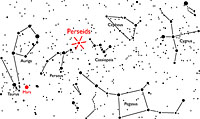

The annual Perseid meteor shower is expected to put on a good show this week for those willing to get up in the wee hours of the morning and wait patiently for the shooting stars.
As the Perseid meteor shower becomes visible in all its glory on 13 August, natural fireworks will fill the sky.
Showers of meteors, or ‘shooting stars’, appear as bright streaks of light in the sky. The display runs through the night.
Dust trails are left behind by every comet as it nears the Sun. As Earth’s orbit crosses the dust ejected by the comet Swift-Tuttle, a regular occurrence every August, it provides a fabulous spectacle for viewers on Earth. As the particles enter the atmosphere, they burn up, producing the fireworks. This phenomenon, called the ‘Perseid’ meteor shower, gets its name from the constellation Perseus, from where the shooting stars seem to come.
This year the Perseids are visible from 17 July to 24 August.
One or two per hour can be seen at the start, increasing to about five to ten per hour in early August. The display will be at its maximum before sunrise on 13 August, when 80 to 100 meteors should be visible every hour, weather permitting.
The best time to go observing is during the pre-dawn hours of 13 August. The occurrence of a new Moon on 12 August will make for perfect observing conditions
Constellation map |
Telescopes or binoculars will not be necessary as the shower is visible with the naked eye. It is important to be in a dark area, without much smog, pollution or illumination.
Do make yourself comfortable – use a reclining chair or spread a blanket on the ground. The shooting stars will appear all over the sky, you need not look in a particular direction. Just make sure your eyes can adapt to dark.
The best time to observe the Perseids will be 2am to 4am. Stargazers are advised to face away from the moon or block it from view behind a wall.
Those unable to see the shower can turn to Twitter for an online meteor watch organised by the Newbury Astronomical Society in the UK and the International Year of Astronomy 2009.
The Twitter Perseids meteorwatch follows on from a similar Twitter Moonwatch organised by the Newbury Astronomical Society in May.
Tonight could be your chance to gatch a glimse of this wonderful sight unfortuatly light pollution from our towns and cities has increased so much in recent years, but head out to the countryside for the perfect place to explore the beauty of the night sky, away from the intrusive glow.
I know I certainly will be... :)


No comments:
Post a Comment